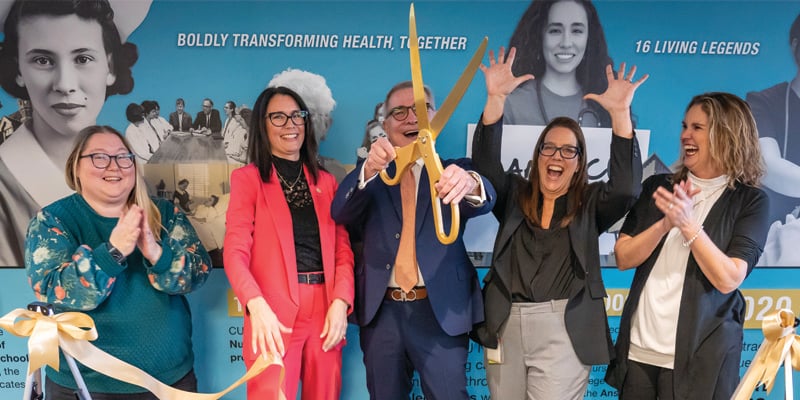The need for nurses continues to grow across the US. But there’s a problem: nursing schools are being forced to turn away qualified applicants because there’s not enough faculty members to teach them.
|
What is a Preceptor? A preceptor can have a broad meaning. Typically related to clinicals, a preceptor is someone who shows a nursing student how to operate within a nursing environment (a hospital, clinic, etc.). A preceptor works with a student during clinical rotations. A preceptor is also used in nursing academia to train nursing students how to work in an academic environment. |
A perfect storm in nursing education has been brewing for a while: faculty who are retiring or on the cusp of retirement paired with fewer nurses pursuing academic careers. The American Association of Colleges of Nursing (AACN) reports the national nurse faculty vacancy rate was nearly 8% in October 2023. And, one-third of the current nursing faculty workforce teaching baccalaureate or graduate courses are expected to retire by 2025.
“We need educators to train the next wave of nursing clinicians,” Patrick Luna, MSN, RN, CEN, says. “If people are passionate about becoming a nurse educator and if this is something that they would like to do, there are avenues, there are pipelines. And one of them is here at the CU College of Nursing.”
Luna is a senior instructor of clinical teaching at the University of Colorado College of Nursing at Anschutz Medical Campus and is currently teaching BS in Nursing students. Luna helps mentor future nurse educators through academic precepting.
What is Academic Precepting?
Academic precepting is similar to student teaching. Students earning their master’s in nursing education are paired with a nursing faculty member for the last few months of their program before graduation. Luna shows them what it looks like working at CU Nursing and the ins and outs of academia.
|
|
“I expose them to different teaching environments and different learners, allowing them to see the dynamics of academia,” he says. “It’s not just teaching, it’s also the professional aspect of what it means to be an academic nurse educator. If you’re a bedside clinician – this will blow your mind. There’s nothing you did clinically that operates like this. This is a college, so I’m here to guide them and show them what this job entails.”
"If you start trusting yourself and you start trusting your voice and how you can impact these students, you'll start to feel like you're making a difference. That’s what I love to see. And that's the opportunity I'm providing,” CU Nursing Instructor of Clinical Teaching Patrick Luna, MSN, RN, CEN
Luna is precepting Michelle Vuong-Obert, BSN, RN, a nurse who received her BS in Nursing from Marquette University and is currently earning her Master’s in Nursing Education from Colorado State University-Pueblo.
“I love working with students, they’re so eager to learn and become a nurse,” Vuong-Obert says. “I find their motivation so rewarding. They’re so engaged and pay a lot of attention, it’s very admirable. It’s also exciting to see their progress through the program because they learn so much in such a short amount of time.”
Vuong-Obert is usually with Luna one to two days a week, depending on class schedules. One week, she watched Luna teach a day of nursing skills, and the next week, Vuong-Obert will teach the class. He’s there to answer her questions and observe while she leads the class. After the class, the two debrief and Luna can offer his feedback. She will also attend Zoom meetings to learn about the administrative and academic side of things.

CSU-Pueblo MS in Nursing Education student Michelle Vuong-Obert, BSN, RN. |
“There's no replacement for having that time in front of students, learning your style, learning your voice,” Luna says. “This is a unique opportunity, especially in our college where there are so many different aspects of what we do here, and it’s so invaluable for Michelle.”
Vuong-Obert agrees, saying “I’ve been able to prepare my lecture and notes and then teach these concepts in front of students. When students break into groups I’m circulating and answering questions. It’s been very rewarding.”
Exploring Career Options
Luna says one way to encourage students to become nurse educators is to plant the seed in their minds early and identify which students are natural teachers.
“I keep an eye out at the undergraduate level for students who love to teach and you can tell who they are – they’re the ones leading study groups,” he says. “I start putting that bug into their ear and tell them after they have some bedside experience, there’s a place for you to become a nurse educator.”
|
Interested in Precepting? https://nursing.cuanschutz.edu/clinical-education/become-a-preceptor
Additional information: CU Nursing offers opportunities for students interested in nursing education, including a teaching fellowship program.
Gail Armstrong, PhD, DNP, ACNS-BC, RN, CNE, FAAN, is the college’s faculty development coordinator. |
Vuong-Obert always had an interest in teaching, and she was a tutor when she was earning her undergraduate degree.
“I enjoyed giving back the knowledge I learned to students who were a year below me,” she says. “I could help make the connection because nursing is so complex, and there are so many avenues to learn. You have to connect the dots and understand a patient or nursing concept.”
Vuong-Obert wants to start teaching undergraduate nursing students and get them excited about teaching.
“We always need more nursing students, and therefore we always need more educators,” she says. “It’s important to get the word out about these career opportunities and get them interested in teaching.”
“Students come in on their first day and they’re blank slates,” Luna says. “They may have an idea of what they want to contribute to nursing, and that’s important. But we’re providing them opportunities to see nurses who have succeeded in other paths of nursing.”




